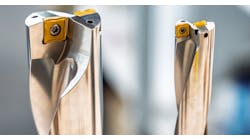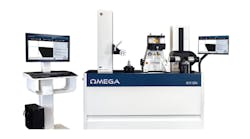To maintain efficiency and profitability in manufacturing operations, milling and turning machines must be equipped to perform under extreme pressures with accuracy and repeatability. During the machining process, a cutting tool may repeatedly cut away at a single blank to produce the required shape. In some applications, the machining of parts can result in the removal of 95% of the volume present in the original blank, leaving behind a machined part tooled from the remaining 5%—a vast amount of cutting for a single part.
Failure can mean reduced part quality so the best cutting edge preparation is required for plant that relies on cutting tooling.
To ensure a stable performance of the cutting tool it is important to achieve homogeneous rounding along the major and minor cutting edges and flutes. To that end there has been much R&D over recent years to achieve greater accuracy and control in edge preparation. The wet blasting process - combining compressed air, abrasive solids and liquid in a slurry form – has proved highly effective in edge honing.
In wet blasting, the water creates a lubricating effect that increases the flow of particles across the surface being treated, to give more consistent and uniform finishes. Wet blasting results in surfaces that are extremely clean and reactive, that respond well to downstream coating processes. To reduce the problems of cobalt leaching additional cleaning and drying stages can be incorporated to offer a complete wet blasting solution.
The most advanced wet blasting systems use powerful software programs to combine and monitor precisely controlled flows of liquid, gas, and solids, which are mixed and then accelerated through focused blasting nozzles. Changing the air and slurry pressures, blast abrasive, slurry concentration, number and angle of attack of the blasting nozzles allows for a range of processing effects to be achieved, from harsh to soft.
For example, media concentration, process temperature, additive and blast pressures can be carefully controlled and monitored to provide an extremely consistent surface finish that can be reproduced time after time. Lubricating the media eliminates static, which can affect coating success, whilst continuously washing parts during processing to deliver the cleanest possible surface.
Cutting Edge and Face Processing
Today, the leading wet blasting providers design and manufacture a range of equipment suitable for cutting edge and face processing of all HSS and carbide tooling, including rotary shank tools (drills, taps, mills, etc.), indexable inserts, hobs, and saws. With increasing performance demands on machine tools and rising market competition, wet blasting is helping tooling manufacturers, coating centers and reconditioning companies to achieve the maximum performance from the tools through edge preparation.
The availability of programmable gun crowns enable tool manufacturers to extend tool operating life, improve surface quality, and increase production capacity. Programmable gun crowns are available that increase the number of blasting parameters that can be programmed for edge preparation, so users can achieve a wider range of radii and k-factors on increasingly complex designs of cutting tools.
As many as eight blast nozzles, each fully adjustable, can offer a range of processing angles. An automated system can give the user precise control over the K factors and edge radii required to increase tool life. This means that with a single gun crown, programmed via a HMI, a customer can hone and finish a range of different tools, each with different K factors and radii, without having to manually change gun angles for different recipes which is a time consuming task for any manufacturer, particularly those involved with low volume batch production of special tools.
Vapormatt recently launched its new wet blasting system, the Vapormatt Sabre, developed in response to small- to medium-volume manufacturers’, coating centers’ and R&D facilities demand for an economical, high-performance wet blasting tool to increase the quality output on a range of cutting tools, without compromising controllability.
The nozzle formation of the Sabre focuses blast guns on the faces and cutting edges to deliver controllable results. Total coverage of tools is ensured, offering edge radii within 0.0002 in. (+/-5 micron) tolerance of specification and a much improved surface for coating adhesion. Because it carries an option to fit both Y- and X-axis nozzle arrangements, the Sabre offers customization opportunities and hybrid functionality.
Round shank tools, ranging from 0.118 in. to 1.81 in. (3 mm to 30 mm) diameter and 1.85 in. to 12.08 in. (46 mm to 307 mm) in length, can be processed but so too can cutting inserts and the Sabre can hold up to 4 Wendt or 3 Manz trays at a time.
Through effective edge preparation a more stable form of the cutting tool can be achieved to offer increased performance by up to 500% (“Influence of Edge Preparation on the Performance of Coated Cutting Tools,” Platit 2007, International Conference on Metallurgical Coatings and Thin Films.)
There is also a need to improve the surface finish of the tools through cleaning, as this will provide a better substrate on for coating. By using edge preparation processes to improve surface Ra coated tools will be more uniform, allowing for more homogenous wear that, again, increases the stability of the cut and reduces the risk of chipping and flaking.
Wet blasting offers exceptionally high quality results that are increasingly being recognized in the machine tool market. And, because no harsh chemicals are used — and no dust is created — wet blasting machines reduce waste and are kinder to the environment, as well as delivering the best possible surface finish.
In recent years there has been a stabilization of global machine tool output, recovering from the global recession that hit the industry hard in 2009 when almost one third of the total output was eliminated. It is now time for the industry to work harder and smarter to extend tooling life expectancy, and wet blasting offers a powerful tool with which to achieve this goal.
Frank Block is the proprietor of Prototools, a distributor with 35 years’ experience in automated manufacturing machinery and systems, and the U.S. representative for Vapormatt.
The Vapormatt Group, based in Taunton, Somerset, England, developed the pressure recirculatory wet blast process, and designs and manufactures manual and automatic surface cleaning, peening and finishing machines. Visit www.vapormatt.com for more detailed information.








